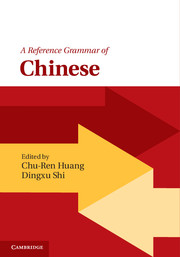Book contents
- Frontmatter
- Dedication
- Contents
- List of figures
- List of tables
- List of contributors
- Preface
- Acknowledgements
- English–Chinese term list
- Chinese–English term list
- 1 Preliminaries
- 2 Syntactic overview
- 3 Lexical word formation
- 4 Verbs and verb phrases
- 5 Aspectual system
- 6 Negation
- 7 Classifiers
- 8 Nouns and nominal phrases
- 9 Relative constructions
- 10 Adjectives and adjective phrases
- 11 Comparison
- 12 Adverbs
- 13 Prepositions and preposition phrases
- 14 Sentence types
- 15 Major non-canonical clause types: ba and bei
- 16 Deixis and anaphora
- 17 Information structure
- Appendix: Punctuation
- Bibliography
- Index
8 - Nouns and nominal phrases
Published online by Cambridge University Press: 05 March 2016
- Frontmatter
- Dedication
- Contents
- List of figures
- List of tables
- List of contributors
- Preface
- Acknowledgements
- English–Chinese term list
- Chinese–English term list
- 1 Preliminaries
- 2 Syntactic overview
- 3 Lexical word formation
- 4 Verbs and verb phrases
- 5 Aspectual system
- 6 Negation
- 7 Classifiers
- 8 Nouns and nominal phrases
- 9 Relative constructions
- 10 Adjectives and adjective phrases
- 11 Comparison
- 12 Adverbs
- 13 Prepositions and preposition phrases
- 14 Sentence types
- 15 Major non-canonical clause types: ba and bei
- 16 Deixis and anaphora
- 17 Information structure
- Appendix: Punctuation
- Bibliography
- Index
Summary
This chapter is concerned with the structure of nominal phrases and the syntax of the lexical categories that function primarily within that structure: determinatives, numerals, classifiers, and nouns.
Distinctive properties of nouns and nominal phrases
The category of nouns consists of lexical items that characteristically represent entities, real or imagined, in the concrete or virtual world. The predominant function of nouns is to be the ultimate head of nominal phrases.
Summary of defining properties of nominal phrases
Nominal phrases are prototypically capable of functioning as an argument in clause structures, namely, as the subject or the object.
A full-fledged nominal phrase characteristically appears in the order of DET(erminer)–NUM(ber)–CL(assifier)–N(oun), as in 那三条鱼 na4 san1 tiao2 yu2 ‘those three fish.’ Although the sequential order of DET–NUM–CL–N cannot be altered, nominal phrases with one or more positions not filled with any lexical item are common.
Summary of defining properties of nouns
Functions: In addition to being the ultimate head of nominal phrases, nouns sometimes function as dependents of other elements, such as the modifier of another noun, as in 火车站 huo3che1zhan4 ‘train station’ and 家具商店 jia1ju4 shang1dian4 ‘furniture store’; the modifier of a verb, as in 枪杀 qiang1sha1 ‘gun-kill, to kill with a gun’ and 油炸 you2zha2 ‘oil-fry, to deep fry’; and the object in a compound verb, such as 怀疑 huai2yi2 ‘hold-suspicion, to doubt’ and 投资 tou2zi1 ‘put-in money, to invest.’
Inflection: There is no overt inflectional marking on nouns for gender, case, or agreement, but pronouns can take the suffix –们 men0 ‘PL’ to indicate plurality, as can human nouns sometimes. Other than the suffix –们 for pronouns and human nouns, plurality is represented by relevant numerals and classifiers in a nominal phrase.
Structural position: The noun always occupies the final position of a nominal phrase. The modifier always precedes the modified.
Pronouns
Pronouns are treated as a subcategory of nouns, in the sense that they have functions similar to nouns, although they typically stand alone in nominal phrases.
Other functions of nominal phrases
In addition to the function of argument in clauses, nominal phrases can function as the object in preposition phrases, while temporal and/or locative nominal phrases can function as adverbials.
- Type
- Chapter
- Information
- A Reference Grammar of Chinese , pp. 199 - 255Publisher: Cambridge University PressPrint publication year: 2016
- 6
- Cited by

